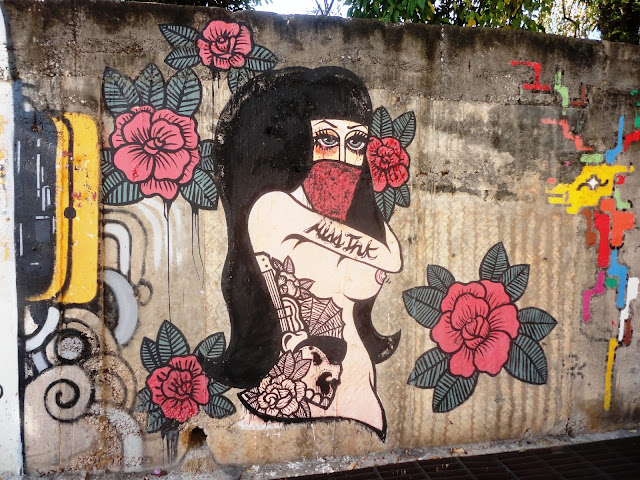19. Battambang, Cambodia: Back from Genocide

(Mural in Battambang painted by five artists)
The city of Battambang was once -- and may yet be again -- Cambodia's cultural capital. Before the 1975-79 genocide that wiped out up to two-million people, it was home to many of Cambodia's most prominent artists. This included the man known as "The Cambodian Elvis", Sinn Sisamouth and the woman regarded as the best female rock singer, Ros Sereysothea:
Unfortunately, musicians, artists and intellectuals were among the first victims targeted by the Khmer Rouge. Sisamouth and Sereysothea, and eventually one in four or five Cambodians, died in the holocaust.
Today, Battambang, despite being the country's second-largest city, has a tranquil stillness to it that is missing in dusty, congested, noisy and motorcycle-strewn capital Phnom Penh and (gateway to Angkor Wat) Siem Reap. It's sort of a quiet melange of Chinese shop houses, French colonial buildings, and trendy restaurants, pubs and art galleries.
More than three-and-a-half decades after the Khmer Rouge were kicked off their genocidal perch by the Vietnamese, Battambang is finally beginning to re-emerge as Cambodia's cultural hub. It has more artists per-capita than any other Cambodian city. It's now considered alright, even good, to be an artist. Better still, it's safe to admit to it.
Battambang has a very strong cultural support infrastructure anchored by the performing arts school Phare Ponleu Selpak. Phare, as it's known for short, has more than 1,000 young, disadvantaged Cambodians studying circus skills, as well as theatre, painting, drawing, design and animation.
Cambodia is a very youthful country. The median age, depending on which source you believe, is 21-24. They bring a tremendous vitality and energy - and a lot of colour - to both their street and canvas art. Take, for example, our masthead photo. In fact, let's break it down a bit. The woman on the far left is Ros Sereysothea, painted by 29-year-old, self-taught artist Chov Theanly:
Theanly (Cambodians list their first names last), who can usually be found painting with oil on canvas, frequently shows his figures with their noses just above a "waterline" to underscore that Cambodians are barely surviving.
The next two parts of the mural were painted by 32-year-old Khchao Touch:
Obviously, there's some patch-up work needed, which Touch will take care of as soon as she can find a spare moment away from being a mother, wife, and co-owner of a store and restaurant/bar/art gallery.
Like Theanly, Touch does most of her work on canvas. Unlike Theanly, she is a graduate of Phare. We spent a pleasant few hours with Touch and you'll find out more about her and her art in our next post.
One part of the mural virtually screams out to be noticed:
One thing we do know a lot about is the restaurant behind the wall. It's called Jai Baan (Rice Bowl) and is a social enterprise that takes kids off the streets, teaches them restaurant skills on site, as well as English. It consistently ranks as the No.1 or 2 Battambang restaurant on Trip Advisor. And that's not a sympathy vote - we can attest to that personally. During our meal there, the service was excellent, the wait staff was very professional and friendly, they could answer questions about the food, and the pan-Asian food was the best we had in our three weeks in Cambodia. They also display and sell art inside the restaurant.
Another great place to see street and other forms of art is the Sammaki Gallery, an artist-run, not-for-profit, community art space:
The inside wall surrounding the art space is brightly decorated with street art by the likes of Ot Veasna:
A. THY
And a few artists that are unknown to us:
As we entered the gallery, we could see a number of Ot's canvas works placed carefully on the floor. Clearly, the gallery was preparing for an exhibition of his works:
Ot was definitely the man of the hour, because he also had another show on at the same time at the Lotus Gallery Bar.
The Lotus is co-owned by Touch and her husband Darren Swallow. In Battambang, artists don't compete against each other, they help each other climb to new heights.
There's probably one more thing you should know about Ot. We didn't tell you about it up front because we wanted you to view him first as what he is: an enormously talented, wildly imaginative and hugely creative artist.
But he's also had a tough life, even by Cambodian standards. Ot's father ran away when his mother was pregnant with him. He was born unable to hear or speak. His mother kept him out of school, so he can't read or write and can only sign a little. And yet what a truly amazing world and cast of characters he has invented for himself - and for us. Yet another example of the strength and resilience of the Cambodian spirit.



























